In cloud infrastructure, audit readiness is not just an administrative task; it’s an engineering responsibility that directly impacts the security, compliance, and integrity of the entire system. Audit readiness, especially in cloud-native environments, means that your system can demonstrate compliance with regulatory standards (such as SOC 2, PCI, or HIPAA) at any given moment without scrambling to pull evidence or fix drifted configurations.
At its core, audit readiness has four important components:
- Resource visibility: Knowing what resources are live, what’s in your infrastructure-as-code (IaC), and ensuring both match up.
- Enforcement of security policies: Continuously ensuring that security practices are being followed across both live infrastructure and code.
- Audit trail for infrastructure changes: Tracking who changed what and when, with proper logging and visibility into every action.
- On-demand evidence generation: Having all the documentation, logs, and reports auditors need ready and accessible.
These aren’t just features of a good DevOps culture; they’re the foundational blocks that make sure a company can prove compliance without manual intervention. Cloud environments are dynamic, and what’s compliant one day can drift and break tomorrow. Keeping this in check is the responsibility of engineering, not just GRC (governance, risk, and compliance) teams.
In a recent Reddit thread, a scenario highlighted the lack of visibility into cloud practices: a company didn’t realize that its cloud provider had been misconfiguring encryption on their resources, leaving sensitive data exposed. By the time this was discovered, the damage had already been done. If the company had visibility into the live configuration and enforced encryption policies at the infrastructure level, this issue could have been avoided.
As cloud environments become increasingly complex, the cost of not being audit-ready becomes too great to ignore. Firefly’s approach aims to address these issues by automating important elements of audit readiness, giving you back the time and energy spent solving compliance problems.
Why Cloud Infrastructure Needs to Be Audit-Ready
Audit readiness in cloud infrastructure isn’t just a compliance formality but a foundational requirement for operating securely, efficiently, and at scale. In highly dynamic environments where infrastructure is created, updated, and destroyed in real-time, you need systems that continuously validate the security posture, track misconfigurations, enforce policy, and expose drift before auditors or attackers do. Here’s why it matters.
Regulatory Compliance: Prove It, Don’t Just Claim It
Many organizations fall under strict regulatory frameworks like GDPR, HIPAA, PCI DSS, or SOX. These aren’t passive policies; they demand technical enforcement around encryption, access control, data residency, and change management.
Cloud audits validate that your infrastructure adheres to these controls not just in IaC, but in the actual deployed environment. For example, if a healthcare application stores PHI on an unencrypted EBS volume, even temporarily, you’re out of compliance with HIPAA, regardless of your Terraform intent. Audit readiness means being able to surface such violations immediately, prove they were remediated, and show an immutable trail of changes tied to owners and timestamps.
Data Security: Hardening Through Visibility and Control
Audit readiness directly intersects with data security. Infrastructure misconfigurations such as open security groups, missing KMS encryption, or overly permissive IAM roles are often exploited because they go undetected at runtime.
Being audit-ready means having active detection in place. For instance, you should be able to show that:
- All customer data is encrypted in transit (via TLS 1.2+) and at rest (via KMS/SSE)
- IAM access follows least privilege principles, validated by role-boundary policies.
- No important resources (like S3 buckets, RDS instances, or Secrets Manager values) are exposed without justification or oversight.
Security incidents often stem not from bad actors, but from untracked changes and a lack of enforcement. Audit readiness fixes that.
Cost Optimization: Catch Misuse and Waste Early
Audit readiness isn't just about compliance; it’s also about operational hygiene. Regular audits can surface idle EC2 instances, untagged resources that bypass cost tracking, over-provisioned RDS clusters, or unused EBS volumes left running in non-prod environments.
For example, if you have multiple test environments with no TTL (time-to-live) automation and no tagging enforcement, resources will accumulate, and cost visibility will degrade. An audit-ready system enforces tagging, usage-based policies, and lifecycle rules that ensure resources are accounted for, both operationally and financially.
Operational Efficiency: Find the Friction Points
Audits expose more than just security holes; they also reveal broken processes. Weak CI/CD approval flows, over-scoped IAM permissions or misaligned access patterns across cloud accounts show up during audit reviews. If a developer can bypass pipeline controls and deploy directly to production via the AWS console, that’s not just a process flaw, it’s an operational risk.
Audit readiness helps organizations fix these inefficiencies early. It validates whether SSO/MFA is enforced across cloud accounts, whether access to production environments is gated and logged, and whether change management aligns with the policies defined in internal GRC tooling.
Continuous Improvement: Drift Detection as Feedback Loop
Cloud infrastructure is not static. What passes a compliance check today can drift tomorrow. That’s why audit readiness must be continuous, not point-in-time.
Regular audits act as a feedback loop. They show whether your drift detection tools are catching real-world divergence, whether policy enforcement is consistently applied across all stages (dev → staging → prod), and whether the team is closing gaps or accumulating tech debt. With each cycle, you're not just preparing for the next audit, you’re strengthening your infrastructure baseline.
Stakeholder Trust: Auditable Systems Build Credibility
Customers, partners, investors, and even internal stakeholders expect a secure foundation. When you can demonstrate that your cloud infrastructure is governed by live policy checks, automated drift detection, role-based access controls, and immutable logs, it sends a clear message: this system is trustworthy.
Being audit-ready means you’re not reacting to findings, you’re preventing them. And that gives your security, compliance, and engineering teams the confidence to move fast without creating unknowns.
The True Cost of Audit Readiness Without Automation
If you’ve ever gone through a SOC 2 or ISO 27001 audit without automation in place, you already know the pain isn’t just in passing the audit, it’s in getting ready for it. The actual cost isn’t just the auditor’s invoice. It’s the engineering hours burned chasing infrastructure state, fixing drift, and pulling together fragmented evidence.
For SOC 2, this often means manually tracking security controls and ensuring everything from encryption standards to access controls is aligned across your cloud resources.
ISO 27001 is about ensuring that your information security management system (ISMS) is correctly documented and tested, while security tools and infrastructure management remain disconnected. Every time a compliance deadline approaches, it becomes a fire drill because the system wasn’t designed to be audit-ready by default. Without automation, you’re left scrambling to track down logs, screenshots, and documentation, which are often spread across different systems, leading to last-minute fixes and unnecessary complexity.
Asset Discovery: You’re Rebuilding State from Scratch
Cloud environments are constantly changing - instances scale up and down, developers spin up ad-hoc buckets, and workloads deploy across AWS, GCP, and Kubernetes. But when audit prep starts, the first task is usually building a full inventory: “What do we have running, and where?”
Without a live inventory system, this turns into a nightmare:
- Grepping through Terraform modules.
- Logging into multiple cloud accounts and regions, and sometimes even different services, to manually scrape EC2, S3, RDS, EKS, and other resources.
- Manually exporting CSVs from the console just to figure out what resource exists.
And this isn’t just tedious, it’s error-prone. Resources go unmanaged because someone created them outside of IaC. Shadow infrastructure ends up completely invisible to compliance.
Compliance Scripts: Patchwork and Fragile
To check for violations, most teams have some internal scripts, written months ago by someone who’s since left. Maybe it checks for unencrypted S3 buckets or public security groups. But it’s not integrated, not comprehensive, and rarely maintained. And it certainly doesn’t support multi-cloud or newer services.
These scripts:
Run ad-hoc, only when someone remembers.
You have a script that checks for S3 encryption, but it only runs manually when someone remembers. An S3 bucket gets created without encryption, and it goes unnoticed until a security audit or compliance request prompts someone to run the check again.
Don’t track remediation over time.
Your script checks if EC2 instances have the right tags, but it doesn't log the fixes. A violation is found, corrected, and forgotten. A few weeks later, a new EC2 instance is created without tags, and there's no way to track that the previous fix wasn't enforced continuously.
Miss resources due to scope creep or IAM issues.
Your script checks EC2 and S3, but misses IAM roles or Lambda functions. During an audit, you discover that IAM permissions on Lambda functions are misconfigured, but your script didn’t catch it because it wasn’t scoped properly or didn’t have the right IAM permissions.
Triggered by change requests, audits, or standups.
You only run compliance checks when there’s a change request, security audit, or a question in a standup. This means that, in between, resources can drift out of compliance, and no one notices until the next event forces a check.
So by the time you get to audit prep, you’re running partial checks and crossing your fingers that nothing important slipped through.
Untracked Cloud Resources: When IaC Stops Matching Reality
Terraform is only as accurate as the discipline around it. Drift happens when someone fixes a production issue by changing a security group in the AWS console or forgets to include a new S3 bucket in the IaC repo. Now you’ve got “ghost” infra: real resources that aren’t declared anywhere.
When auditors request proof that everything is codified and version-controlled, gaps in your infrastructure management process can derail that claim. Without proper automation, you're left dealing with the following manual tasks:
- Manually importing resources back into Terraform to align the live infrastructure with the desired code state.
- Writing import blocks for each resource, ensuring the live environment matches the predefined configurations.
- Reconciling local vs. remote state whenever drift occurs, complicating the effort to maintain version-controlled environments.
- Retrofitting modules to force real-world infrastructure into code templates, just to meet compliance standards.
This manual work is essential because compliance audits can't proceed without it. However, this reliance on manual processes increases the chances of error and consumes significant engineering time.
Evidence Collection: Manual, Messy, and Incomplete
Even once everything’s clean, you still need to prove it. Most orgs still rely on:
- Screenshots of console settings.
- CLI outputs are pasted into Notion pages.
- CloudTrail logs are exported manually and annotated.
None of this is timestamped properly, versioned, or linked to actual policies. You spend days assembling PDFs and writing explanations like “Yes, this S3 bucket had public access for 12 hours during testing, but was remediated on Jan 14…”
Auditors need clean, timestamped proof that policies are enforced and violations are resolved consistently, not tribal knowledge or post-hoc justifications.
Engineering Time: 2–4 Weeks, Every Quarter
Add all this up, resource discovery, IaC reconciliation, compliance scanning, and evidence packaging, and you’re burning roughly around 2–4 weeks of senior engineering time per audit cycle. And if you’re doing SOC 2 Type II or ISO 27001, that’s not once a year, it’s quarterly. That’s 8–16 weeks a year gone to manual cloud audit readiness. Not to mention the thousands of dollars annually you’re spending on consultants, internal reviews, and tooling to support that effort.
And worse, most of that time is wasted because of the next audit cycle. You’re starting over again. Why?
Why It Keeps Happening: No Continuous Enforcement
Audit prep is so repetitive because there’s no system watching your cloud for drift, misconfigurations, or violations in real time. No central policy engine. No automated tagging enforcement. No evidence collection pipeline.
So even if everything was clean last month, there’s no guarantee it still is now. You’re always behind. You’re always reacting. And every audit becomes a mad dash to make the infrastructure look compliant, even if it isn’t engineered to stay that way.
How Firefly Solves Audit Readiness at the Infrastructure Layer
Firefly is designed to automate the most time-consuming aspects of audit readiness and compliance management in cloud infrastructure. By integrating real-time monitoring, policy enforcement, and automated remediation, Firefly ensures that you stay audit-ready without the manual overhead. Here’s a workflow below simplifying how this happens in practice:
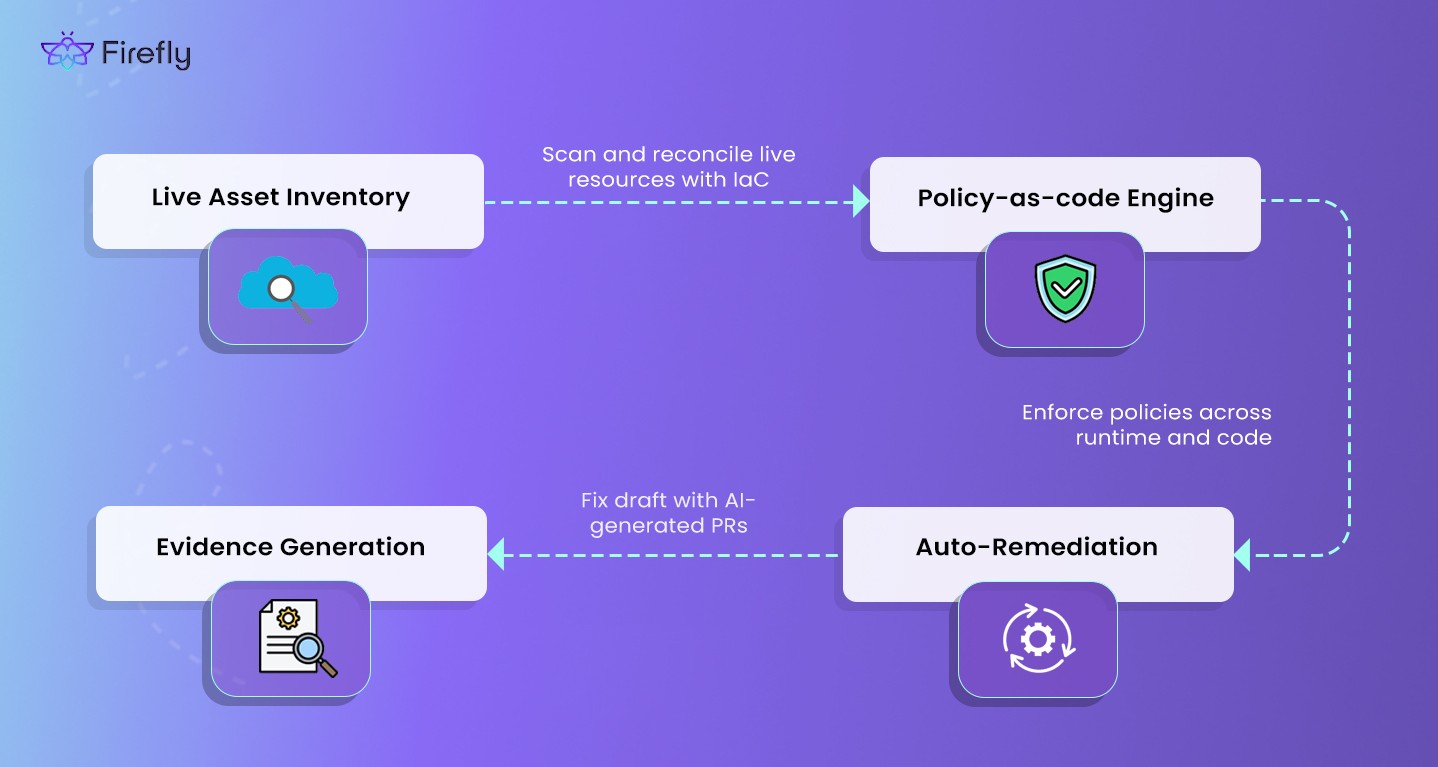
a. Live Asset Inventory
The first step to audit readiness is knowing exactly what is running in your cloud environment at all times. However, with cloud infrastructure constantly changing, keeping track of all resources can be a daunting task.
Firefly provides you with continuous visibility and automated tracking of your entire cloud environment. Here's how it shows you the status of all resources, ensuring you have an up-to-date, accurate inventory:
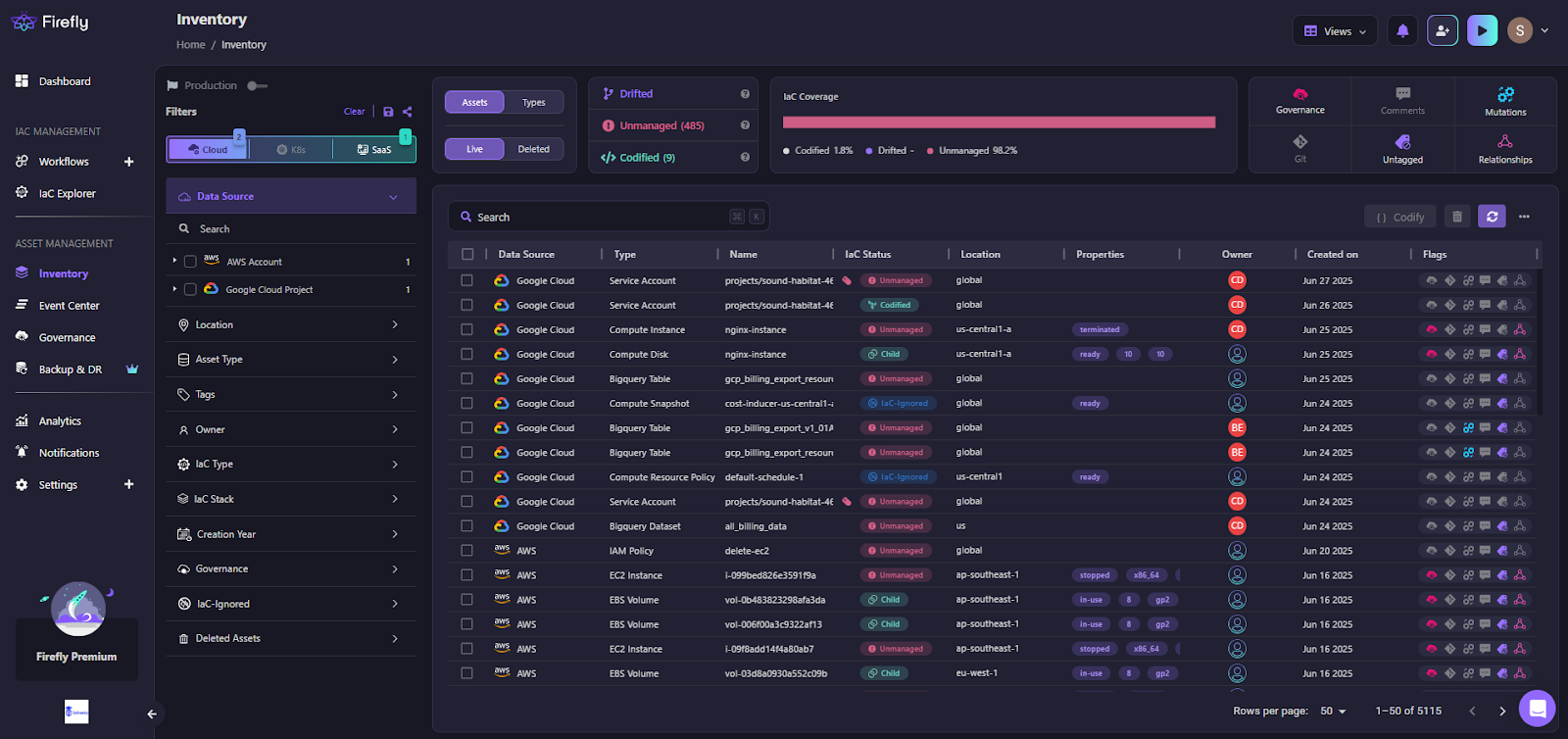
The inventory above keeps you informed about the status of all your resources, providing the clarity needed for audit readiness by:
- Real-Time Discovery: Firefly continuously scans and tracks resources across AWS, GCP, Azure, Kubernetes, and GitHub, providing a live inventory of all your assets.
- IaC and Live Infrastructure Reconciliation: Firefly not only tracks resources in the cloud but also reconciles these with your infrastructure-as-code (IaC) configurations, such as Terraform, CloudFormation, and others. This ensures that your live resources align with your codebase, providing a single source of truth and making it easier to detect any discrepancies or drift.
This feature gives teams continuous visibility, allowing you to know exactly what’s running and ensuring that resources are compliant at all times.
b. Policy-as-Code Engine
Policy-as-code is a cornerstone of Firefly’s approach to compliance and governance. It allows you to define, enforce, and automate policies across your cloud infrastructure, ensuring that compliance is continuously maintained by:
- Unified Policy Engine: Firefly enables the creation and enforcement of policies that work across all clouds and IaC tools. Rather than managing separate policy systems for AWS, GCP, Azure, and Kubernetes, Firefly provides a unified policy dashboard shown in the snapshot below that shows policy coverage across different cloud providers and IaC tools.
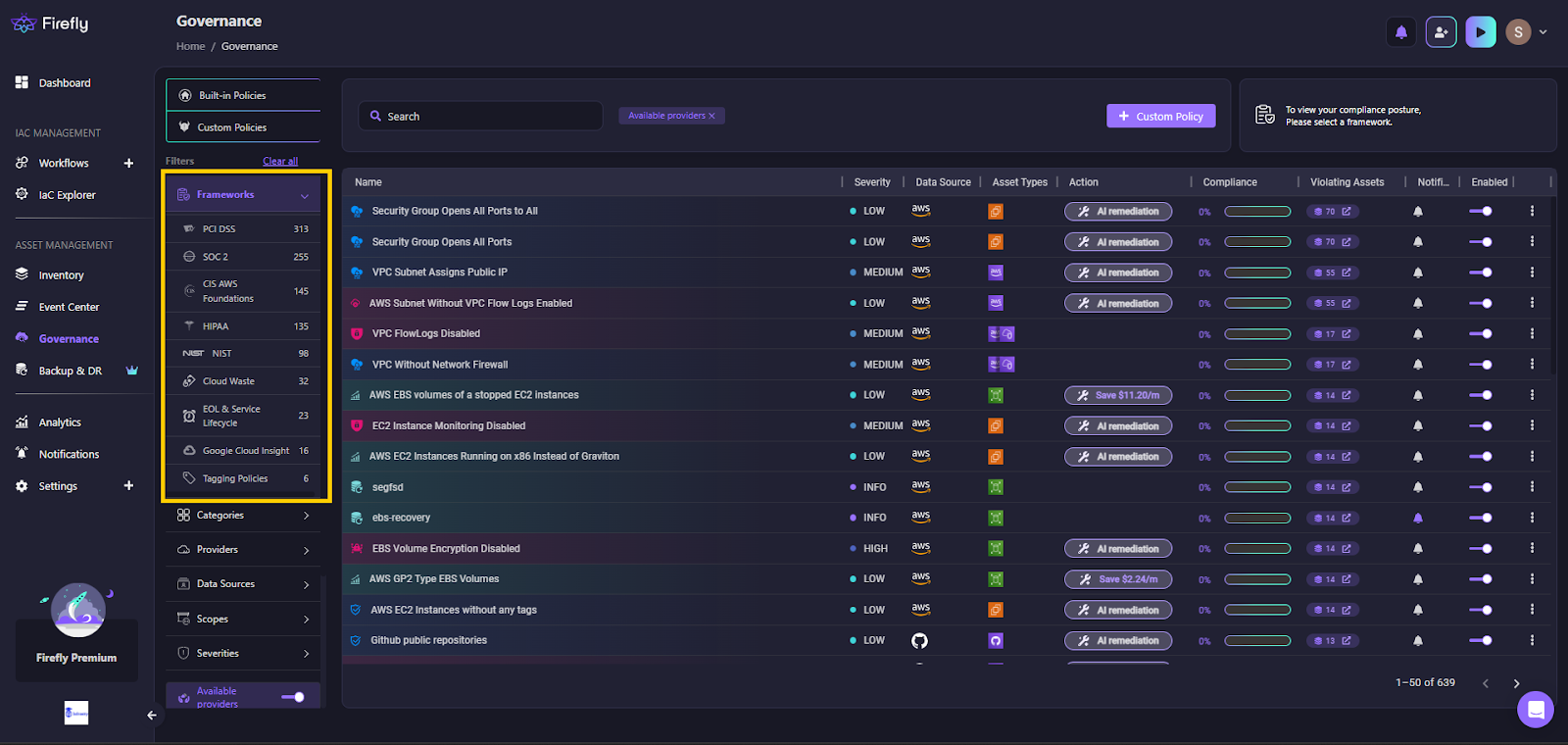
- Pre-built Compliance Rules: Firefly comes with an extensive library of pre-built policies based on industry standards like SOC 2, PCI-DSS, HIPAA, and ISO 27001. Examples include:
- Ensure encryption is enabled on all databases.
- Preventing public access to sensitive resources like S3 buckets.
- Requiring owner tags on every resource to ensure accountability.
- Ensure encryption is enabled on all databases.
Custom Policy Creation: If you need more control, Firefly supports the creation of custom policies using Rego, the declarative language for Open Policy Agent (OPA). This flexibility lets you encode any specific compliance rule into Firefly’s engine. For example, you could enforce that all EC2 instances must be tagged with an "Environment" tag to align with organizational standards.
Here’s a screenshot of the Rego code editor in Firefly, where custom policies are created, such as the “Environment” tag rule for EC2 instances:
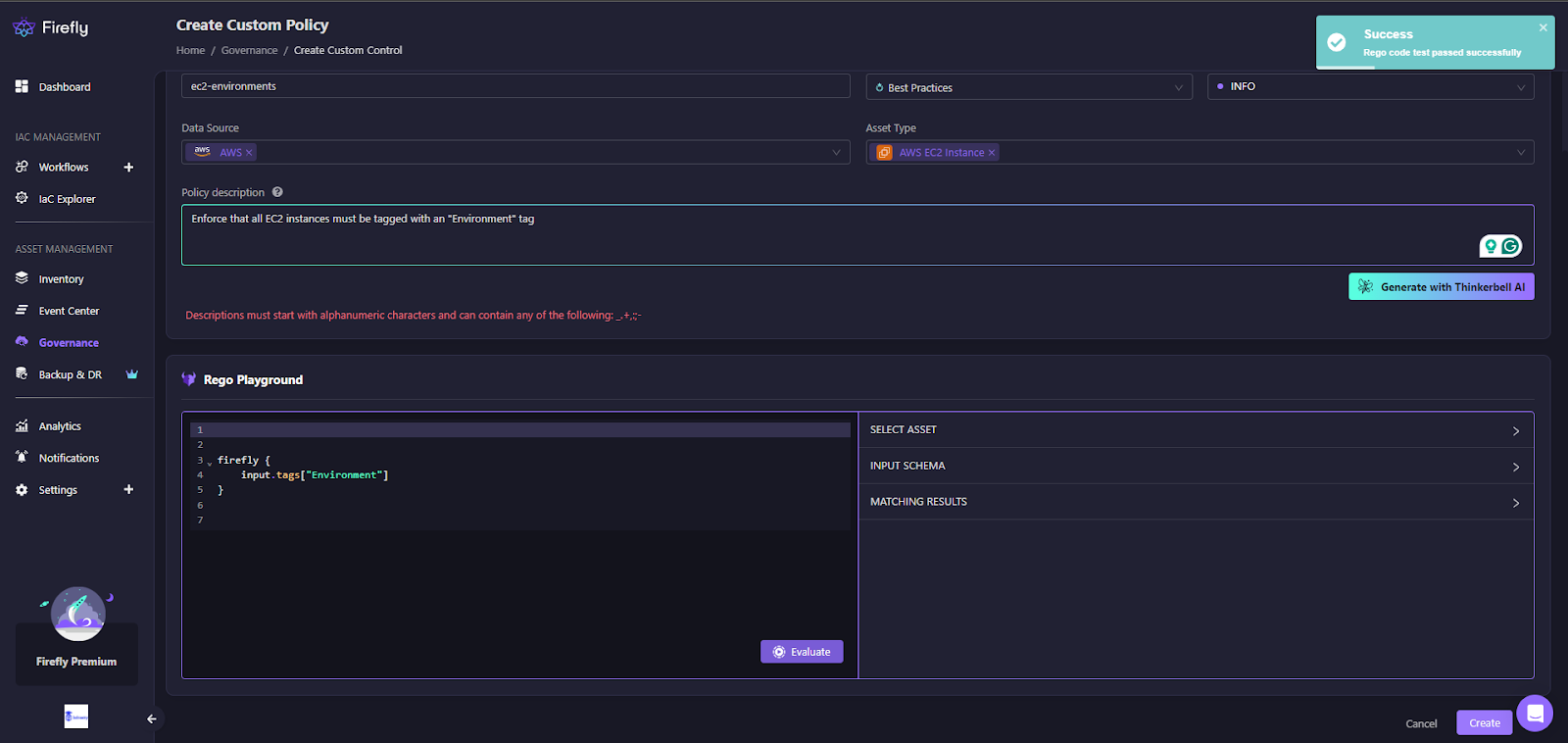
Custom policy in Rego:
firefly {
input.tags["Environment"]
}
This policy ensures that each EC2 instance has an "Environment" tag. If the tag is missing, Firefly will flag it as a violation.
Firefly applies these policies continuously, ensuring your cloud environment remains compliant at all times. The platform scans resources for violations, flags them, and provides immediate visibility into non-compliance.
c. Auto-Remediation
Firefly continuously compares your live cloud environment with your intended IaC state. For example, if an S3 bucket is created without default server-side encryption, even though your security baseline requires it, Firefly flags the misconfiguration as soon as it detects the drift.
Here’s how Firefly flags this violation in the Governance panel:
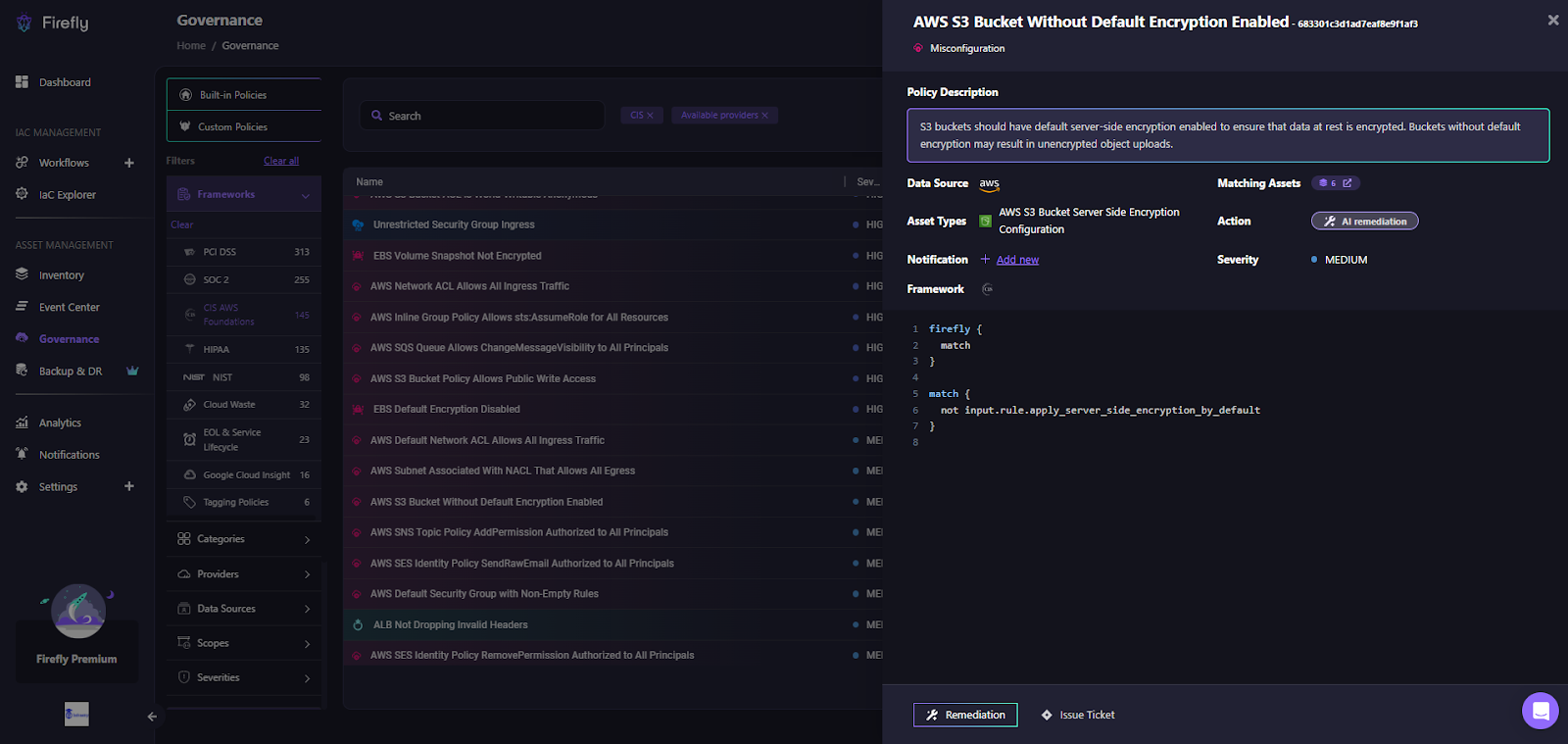
In the example above, Firefly has surfaced a policy violation titled “AWS S3 Bucket Without Default Encryption Enabled”. This detection is backed by a Rego policy that explicitly checks for the apply_server_side_encryption_by_default setting on your S3 bucket configuration. If this setting is missing, the bucket is considered non-compliant.
You can see the matching assets (in this case, 5 S3 buckets) and view the exact logic used for evaluation. The policy is also mapped to the CIS AWS Foundations benchmark, making it easier to tie detection back to compliance frameworks.
AI-Generated Remediation: Once a violation is identified, Firefly’s remediation flow kicks in, backed by Thinkerbell AI. Depending on whether the resource is managed via IaC or not, Firefly generates the right fix. Without Firefly, fixing compliance issues means manually checking each resource, figuring out if it’s managed by IaC, and writing custom scripts or Terraform patches.
Here’s how Firefly presents remediation options for the affected buckets:
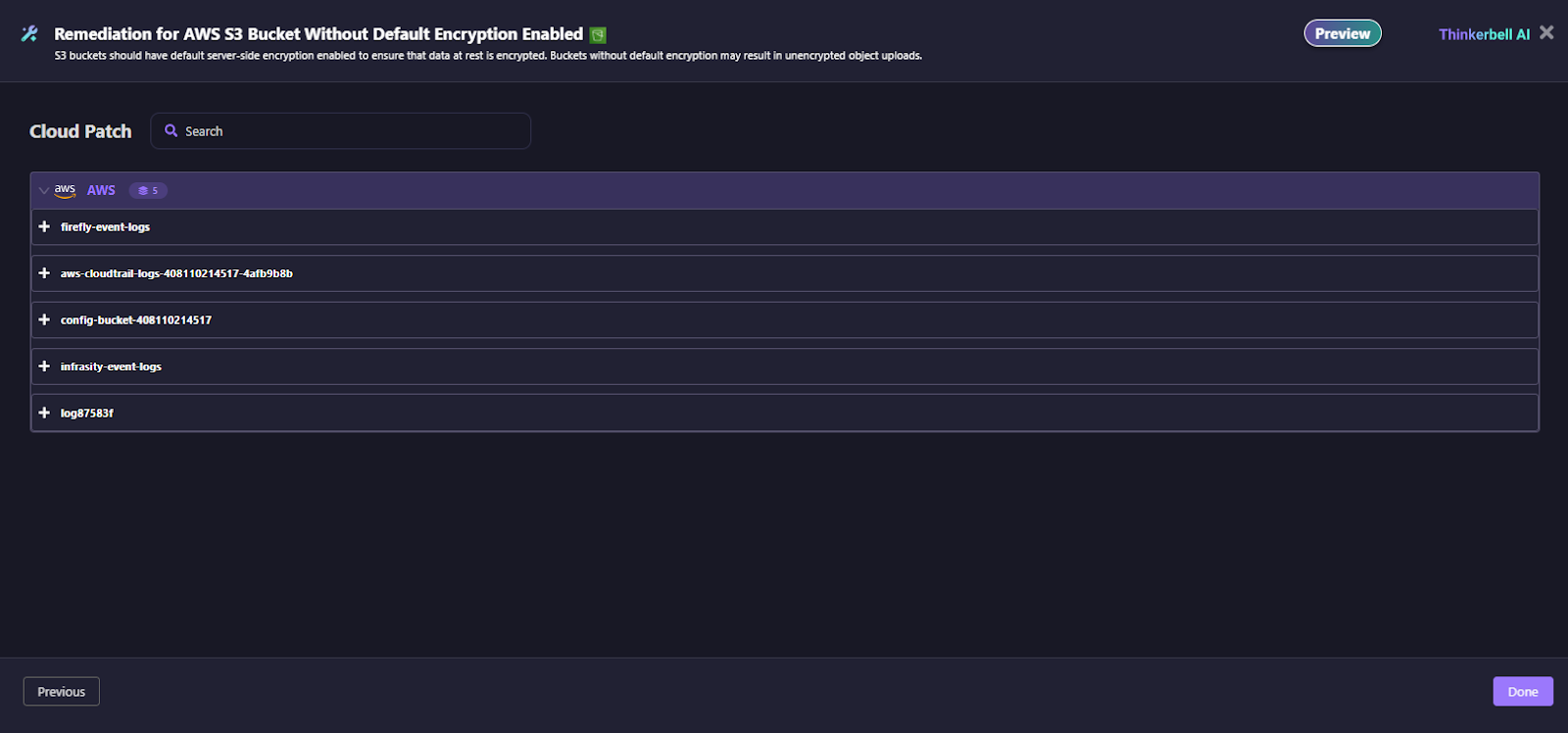
This view shows all five affected S3 buckets. For each, you can expand the entry to see the exact patch Firefly will apply. If the resource is not part of your Terraform codebase, Firefly suggests a direct Cloud Patch (via the AWS API) to enforce encryption. If it's codified, Firefly can generate a PR with the corrected Terraform block.
Why Firefly is Built for Audit-First Cloud Teams
Firefly is designed from the ground up to support audit-heavy environments. It provides first-class support for continuous compliance by automating the most time-consuming parts of cloud audits, asset inventory, policy enforcement, change detection, and remediation. Instead of scrambling before every cloud audit, teams using Firefly operate in an always-audit-ready mode.
With real-time visibility into your cloud footprint, tight IaC reconciliation, and automated policy-as-code enforcement, Firefly turns compliance from a periodic burden into a background process, no spreadsheets, no fire drills, no surprises.
In the next section, we’ll walk through best practices to help you further streamline cloud audit readiness using Firefly.
Best Practices for Cloud Compliance Audits
To ensure your cloud infrastructure remains compliant and audit-ready, follow these best practices for a proactive and streamlined compliance process.
1. Data Residency and Governance
- Data Residency Compliance: Ensure that data is stored in compliant regions based on regulations like GDPR or HIPAA.
- Automate Data Lifecycle Management: Implement automated policies for data retention, archiving, and deletion to meet regulatory requirements and minimize the risk of non-compliance.
2. Regular Audits and Assessments
- Internal and Third-Party Audits: Conduct regular internal audits and work with third-party auditors for an unbiased compliance assessment.
- Vulnerability Testing: Regularly perform vulnerability and penetration tests to identify and mitigate security risks before they impact compliance.
3. Managing Third-Party Risks
- Vendor Compliance Certifications: Review third-party vendor certifications like SOC 2 and ISO 27001 to ensure they meet your compliance standards.
- Clear SLAs: Establish clear SLAs with vendors, defining their role in maintaining security and compliance.
By following these cloud auditing best practices, you can ensure continuous compliance, streamline your audit processes, and reduce risk, allowing your teams to focus on innovation rather than manual compliance efforts
FAQs
What is Data Auditing in Cloud Computing?
Data auditing in cloud computing refers to the process of tracking and reviewing data access, usage, and changes within a cloud environment. It involves monitoring data to ensure it is handled in compliance with internal policies and regulatory requirements. Auditing helps identify potential security threats, and unauthorized access and ensures that data storage and processing meet the relevant compliance standards like GDPR or HIPAA.
What is a Cloud Security Assessment?
A cloud security audit assessment is a comprehensive evaluation of a cloud infrastructure's security posture. It involves reviewing configurations, access controls, and processes to identify vulnerabilities and ensure that cloud environments meet security standards and compliance requirements. The assessment includes risk analysis, penetration testing, vulnerability scanning, and compliance checks to safeguard sensitive data and systems.
Which AWS Service is Used for Auditing?
AWS CloudTrail is the primary service used for auditing in AWS. It provides detailed logs of all API calls made within an AWS account, enabling you to track who accessed what resources, when, and why. This is crucial for maintaining compliance and conducting security audits. AWS Config can also be used for compliance auditing, as it tracks changes in AWS resources and ensures they align with your defined configuration standards.
Which Four Options Are the 4 a's in Cloud Auditing?
The 4 A's in cloud auditing refer to the four key principles that must be maintained for effective auditing:
- Authentication: Ensuring that users are who they say they are and enforcing strong identity management policies.
- Authorization: Controlling access to resources based on permissions and roles to ensure users can only access data they are authorized to view or modify.
- Accounting: Tracking and recording actions performed on resources, ensuring all actions are logged and can be reviewed.
- Auditability: The ability to review, verify, and analyze audit logs to ensure compliance and investigate any security incidents.


